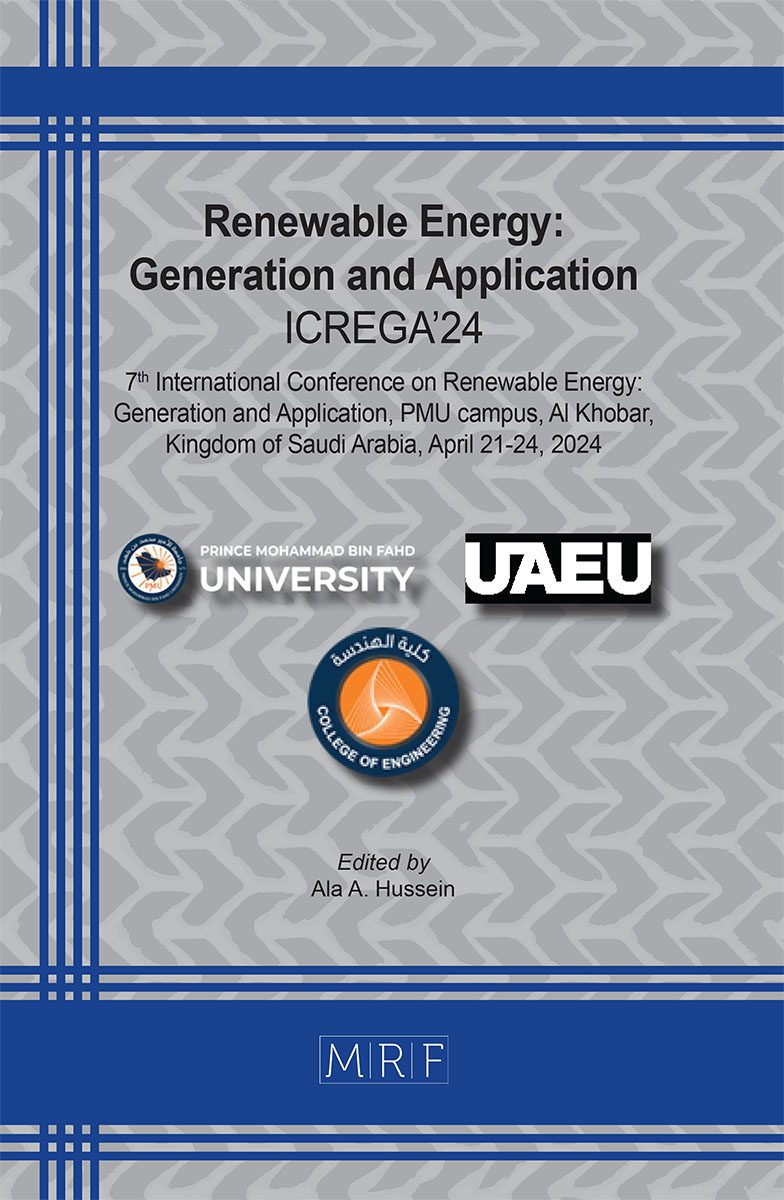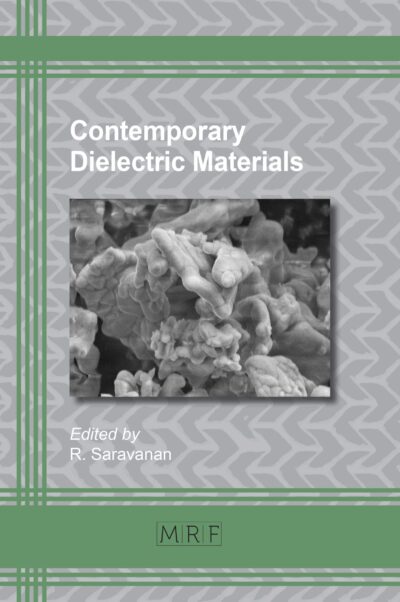–
Cyclic voltammetric and characterization studies of electrodeposited copper-indium for thin-film solar cell application
Leher Farooq
download PDFAbstract. Copper-indium layers were grown on a carbon substrate by a one-step electrodeposition technique. Four deposition electrolytes were prepared: Two unitary electrolytes comprising of 300 mM copper (II) chloride and 700 mM trisodium citrate and 300 mM indium (III) chloride and 700 mM trisodium citrate; two binary electrolytes comprising of 300 mM copper (II) chloride, 300 mM indium (III) chloride and 700 mM trisodium citrate for deposition at potentials of -0.6 V and -0.9 V, respectively. The pH of the solution was left unaltered at 4.8. X-ray diffraction studies showed the produced copper indium layers had an amorphous structure. From the scanning electron microscopy studies, it was found that copper indium layers indicated a small grain size and grain shape was irregular. The structure was not compact. Energy dispersive spectroscopy showed presence of low percentages of copper and indium in all four samples and stoichiometric molar ratios of Cu:In of 1:1 can be achieved using deposition potentials between -0.6 to -0.9 V. SEM, EDS and XRD characterization helps in the identification of the reaction mechanism, the structure and morphology of the films deposited under different conditions. These characterization studies will assist in enhancing the efficiency of the thin-films deposited for maximum conversion of sunlight to electricity using this sustainable method. In this present study, an attempt has been made to obtain near stoichiometric films for higher efficiencies.
Keywords
Electrodeposition, Copper Indium Diselenide, Thin-Film Solar Cells, Complexing Agents, Cyclic Voltammetry, Energy Dispersive X-Ray Spectroscopy, X-Ray Diffraction, Scanning Electron Microscopy
Published online 7/15/2024, 12 pages
Copyright © 2024 by the author(s)
Published under license by Materials Research Forum LLC., Millersville PA, USA
Citation: Leher Farooq, Cyclic voltammetric and characterization studies of electrodeposited copper-indium for thin-film solar cell application, Materials Research Proceedings, Vol. 43, pp 1-12, 2024
DOI: https://doi.org/10.21741/9781644903216-1
The article was published as article 1 of the book Renewable Energy: Generation and Application
![]() Content from this work may be used under the terms of the Creative Commons Attribution 3.0 license. Any further distribution of this work must maintain attribution to the author(s) and the title of the work, journal citation and DOI.
Content from this work may be used under the terms of the Creative Commons Attribution 3.0 license. Any further distribution of this work must maintain attribution to the author(s) and the title of the work, journal citation and DOI.
References
[1] L. Farooq, A. Alraeesi, and S. Al Zahmi, “A review on the Electrodeposition of CIGS Thin-Film Solar Cells,” in Proceedings of the International Conference on Industrial Engineering and Operations Management, 2019, pp. 158–186.
[2] V. S. Saji, I. H. Choi, and C. W. Lee, “Progress in electrodeposited absorber layer for CuIn(1-x)GaxSe2 (CIGS) solar cells,” Sol. Energy, vol. 85, no. 11, pp. 2666–2678, 2011, https://doi.org/10.1016/j.solener.2011.08.003
[3] Y.-S. Chiu, M.-T. Hsieh, C.-M. Chang, C.-S. Chen, and T.-J. Whang, “Single-step electrodeposition of CIS thin films with the complexing agent triethanolamine,” Appl. Surf. Sci., vol. 299, pp. 52–57, 2014. https://doi.org/10.1016/j.apsusc.2014.01.184
[4] R. Chandran, R. Pandey, and A. Mallik, “One step electrodeposition of CuInSe2 from an acidic bath: A reduction co-deposition study,” Mater. Lett., vol. 160, pp. 275–277, 2015. https://doi.org/10.1016/j.matlet.2015.07.132
[5] M. E. Calixto and P. J. Sebastian, “Solartron analytic,” Sol. Energy Mater. Sol. Cells, vol. 63, no. 4, pp. 335–345, 2000. https://doi.org/10.1016/S0927-0248(00)00053-2
[6] A. Luque and S. Hegedus, “Handbook of Photovoltaic Science and Engineering,” John Wiley Sons, Ltd, pp. 92–100, Jan. 2003.
[7] S. Ruffenach, Y. Robin, M. Moret, R.-L. Aulombard, and O. Briot, “(112) and (220)/(204)-oriented CuInSe2 thin films grown by co-evaporation under vacuum,” Thin Solid Films, vol. 535, pp. 143–147, 2013. https://doi.org/10.1016/j.tsf.2013.01.053
[8] M. Li et al., “CIS and CIGS thin films prepared by magnetron sputtering,” Procedia Eng., vol. 27, pp. 12–19, 2012. https://doi.org/10.1016/j.proeng.2011.12.419
[9] S. Seeger and K. Ellmer, “Reactive magnetron sputtering of CuInS2 absorbers for thin film solar cells: Problems and prospects,” Thin Solid Films, vol. 517, no. 10, pp. 3143–3147, 2009. https://doi.org/10.1016/j.tsf.2008.11.120
[10] H. L. Hwang, C. L. Cheng, L. M. Liu, Y. C. Liu, and C. Y. Sun, “Growth and properties of sputter-deposited CuInS2 thin films,” Thin Solid Films, vol. 67, no. 1, pp. 83–94, 1980. https://doi.org/10.1016/0040-6090(80)90291-6
[11] M. Hashemi, S. M. Bagher Ghorashi, F. Tajabadi, and N. Taghavinia, “Aqueous spray pyrolysis of CuInSe2 thin films: Study of different indium salts in precursor solution on physical and electrical properties of sprayed thin films,” Mater. Sci. Semicond. Process., vol. 126, p. 105676, 2021. https://doi.org/10.1016/j.mssp.2021.105676
[12] M. Esmaeili-Zare and M. Behpour, “Influence of deposition parameters on surface morphology and application of CuInS2 thin films in solar cell and photocatalysis,” Int. J. Hydrogen Energy, vol. 45, no. 32, pp. 16169–16182, 2020. https://doi.org/10.1016/J.IJHYDENE.2020.04.106
[13] J. Leng et al., “Advances in nanostructures fabricated via spray pyrolysis and their applications in energy storage and conversion,” Chem. Soc. Rev., vol. 48, no. 11, pp. 3015–3072, 2019. https://doi.org/10.1039/C8CS00904J
[14] M. E. Calixto, P. J. Sebastian, R. N. Bhattacharya, and R. Noufi, “Compositional and optoelectronic properties of CIS and CIGS thin films formed by electrodeposition,” Sol. Energy Mater. Sol. Cells, vol. 59, no. 1, pp. 75–84, 1999. https://doi.org/10.1016/S0927-0248(99)00033-1
[15] K. Abderrafi et al., “Epitaxial CuInSe2 thin films grown by molecular beam epitaxy and migration enhanced epitaxy,” J. Cryst. Growth, vol. 475, pp. 300–306, 2017. https://doi.org/10.1016/j.jcrysgro.2017.07.010
[16] “Solar Frontier Achieves World Record Thin-Film Solar Cell Efficiency of 23.35%.” .
[17] S. K. Deb, “Thin-film solar cells: An overview,” Renew. Energy, vol. 8, no. 1, pp. 375–379, 1996. https://doi.org/10.1016/0960-1481(96)88881-1
[18] O. Meglali, N. Attaf, A. Bouraiou, J. Bougdira, M. S. Aida, and G. Medjahdi, “Chemical bath composition effect on the properties of electrodeposited CuInSe2 thin films,” J. Alloys Compd., vol. 587, pp. 303–307, 2014. https://doi.org/10.1016/j.jallcom.2013.10.100
[19] J. Herrero and C. Guillén, “Study of the optical transitions in electrodeposited CuInSe2 thin films,” J. Appl. Phys., vol. 69, no. 1, pp. 429–432, Jan. 1991. https://doi.org/10.1063/1.347734
[20] K. K. Mishra and K. Rajeshwar, “A voltammetric study of the electrodeposition chemistry in the Cu + In + Se system,” J. Electroanal. Chem. Interfacial Electrochem., vol. 271, no. 1, pp. 279–294, 1989. https://doi.org/10.1016/0022-0728(89)80082-8
[21] A. M. Fernández and R. N. Bhattacharya, “Electrodeposition of CuIn1−xGaxSe2 precursor films: optimization of film composition and morphology,” Thin Solid Films, vol. 474, no. 1, pp. 10–13, 2005. https://doi.org/10.1016/j.tsf.2004.02.104
[22] A. A. C. Alcanfor, L. P. M. dos Santos, D. F. Dias, A. N. Correia, and P. de Lima-Neto, “Electrodeposition of indium on copper from deep eutectic solvents based on choline chloride and ethylene glycol,” Electrochim. Acta, 2017. https://doi.org/10.1016/j.electacta.2017.03.082














